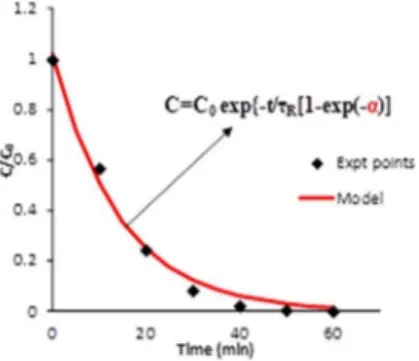HAL Id: hal-02363191
https://hal.archives-ouvertes.fr/hal-02363191
Submitted on 14 Nov 2019
HAL is a multi-disciplinary open access archive for the deposit and dissemination of sci-entific research documents, whether they are pub-lished or not. The documents may come from teaching and research institutions in France or abroad, or from public or private research centers.
L’archive ouverte pluridisciplinaire HAL, est destinée au dépôt et à la diffusion de documents scientifiques de niveau recherche, publiés ou non, émanant des établissements d’enseignement et de recherche français ou étrangers, des laboratoires publics ou privés.
Influence of operating parameters on the single pass
removal efficiency during the photocatalytic degradation
of acrylonitrile
Henrietta Whyte, Cécile Raillard, Albert Subrenat, Valérie Hequet
To cite this version:
Henrietta Whyte, Cécile Raillard, Albert Subrenat, Valérie Hequet. Influence of operating parameters on the single pass removal efficiency during the photocatalytic degradation of acrylonitrile. ECCE12 2019 : 12th European Congress of Chemical Engineering, Sep 2019, Florence, Italy. �hal-02363191�
ECCE12
The 12
thEUROPEAN CONGRESS OF CHEMICAL ENGINEERING
Florence 15-19 September 2019
Influence of operating parameters on the single pass removal efficiency
during the photocatalytic degradation of acrylonitrile.
Henrietta Essie Whyte
1, Cécile Raillard
1, Albert Subrenat
1, Valérie Héquet
11 GEPEA UMR CNRS 6144, IMT Atlantique, DSEE, 4 rue Alfred Kastler CS 20722, 44307 Nantes, France *Corresponding author: Valerie.hequet@imt-atlantique.fr
Highlights
Single-pass removal efficiencies can be improved according operating parameters A complete mineralization can be reached irrespective of initial pollutant
concentration
Conversion vs. mineralization rates show the probable formation of intermediates
1. Introduction
The hospital is a place where the air quality is very important as it plays an important role in the health of both patients and hospital staff. Microbial contamination in relation to nosocomial infections has been at the fore front of hospital air quality whilst chemical contamination is rarely studied [1]. One of the most demanding areas in terms of the air quality is the operating room (OR). Surgeons and operating theatre staff are routinely exposed to pollution from the surgical smoke. The chemicals present in greatest quantity in surgical smoke are hydrocarbons and nitrile compounds among which is acrylonitrile. Barret and Garber [2] reported acrylonitrile concentrations to be between 1 and 1.6 ppm. In ORs air quality is assured mostly by HVAC. However, this is not always enough thus additional treatment devices can be used to purify air. Stand-alone devices that use photocatalytic oxidation (PCO) are becoming increasingly popular to treat indoor air. The aim of this work is to assess if PCO is efficient for removing acrylonitrile and to study the influence of three operational parameters (air velocity, light intensity and initial concentration) on the photocatalytic removal efficiency of acrylonitrile.
2. Methods
A 420 L multi-pass dynamic photocatalytic reactor was used to carry out the PCO experiments. It has been described and modelled in a previous articles [3],[4]. The media used was supplied by Saint-Gobain Quartz (QUARTZEL®) and consisted of quartz fibers coated with TiO2 deposited
through a sol-gel method. The media was irradiated with two 18-W UVC fluorescent tubes (Phillips PL-L series). Acrylonitrile was supplied from a certified commercial gas cylinder produced by Air products. The cylinder contained 150 ppm of acrylonitrile balanced in nitrogen at a pressure of 150 bars. The selected average light intensities (I) ranged from 1 to 4.5 mW.cm-2. The air velocities
corresponding to the selected flow rates (73 - 216 Nm3.h-1) varied from 0.5 to
1.5 m.s-1 and were determined as the ratio between the air flow rate and the cross-sectional area
(0.04 m2) of the photocatalytic module. Initial concentrations (C
0) chosen for the experiments
ranged from 0.5 to 10 ppm which were representative of concentrations reported in the literature. The relative humidity (RH) was maintained at 50% at 20°C to be representative of average humidity levels found in operating rooms in European countries.
3. Results and discussion
First results showed that acrylonitrile is degraded within 1h based on the experimental conditions of C0=2ppm, v=1 m.s-1 and I = 4.5mW.m-2 (Fig. 1). It was observed that the degradation followed a
first order kinetic. The experimental points were then fitted to the model developed by Dumont and Héquet. The model describes the first order decay relationship of concentration vs. time and helps to determine the single pass removal efficiency. It is as follows:
𝐂 = 𝑪𝟎 𝐞𝐱𝐩 − 𝒕
𝝉𝑹 [𝟏 − 𝐞𝐱𝐩(−𝜶)]
(1)
In Eqn. 1 the term α is the single pass removal efficiency and represents the fraction of the total flow treated during the time τR (residence time in the reactor). C is the pollutant concentration at
time t and C0 is the initial pollutant concentration. Numerical resolutions are carried out using
Excel® Solver which is based on the least- square method.
Figure 1. Experimental degradation curve of acrylonitrile fitted to model (C0 = 2 ppm; v = 1 m.s-1; I = 4.5 mW.cm-2). 4. Conclusions
Conclusively, PCO is able to degrade acrylonitrile. The experimental points are well fitted to the model and enable the calculation of the one-pass removal efficiency. Since the global objective is to study the effect that the operating parameters have on the single pass removal efficiency, experiments are conducted at the selected air velocities, light intensities and initial concentrations to determine their influence.
Acknowledgements: the authors thank ATA Medical company and IMT-Atlantique for their financial support.
References
[1] C.-C. Jung, P.-C. Wu, C.-H. Tseng, H.-J. Su, Indoor air quality varies with ventilation types and working areas in hospitals, Build. Environ. 85 (2015) 190–195.
[2] W.L. Barrett, S.M. Garber, Surgical smoke: a review of the literature, Surg. Endosc. Other Interv. Tech. 17 (2003) 979– 987.
[3] A. Maudhuit, C. Raillard, V. Héquet, L. Le Coq, J. Sablayrolles, L. Molins, Adsorption phenomena in photocatalytic reactions: The case of toluene, acetone and heptane, Chem. Eng. J. 170 (2011) 464–470.
[4] É. Dumont, V. Hequet, Determination of the Clean Air Delivery Rate (CADR) of Photocatalytic Oxidation (PCO) Purifiers for Indoor Air Pollutants Using a Closed-Loop Reactor. Part I: Theoretical Considerations, Molecules. 22 (2017).
